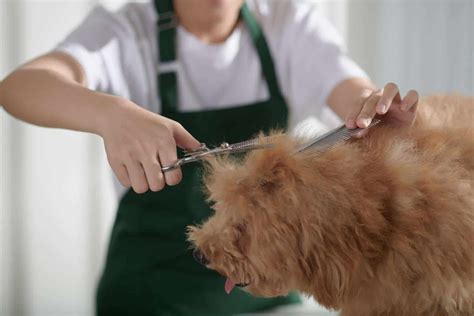As pet owners, we all want to keep our furry friends healthy and happy. Regular grooming is an essential part of pet care, helping to remove dirt, loose hair, and parasites, while also promoting healthy skin and coat. In today’s fast-paced world, it can be challenging to maintain a consistent grooming routine. This article will provide a comprehensive guide to pet grooming, covering everything from choosing the right tools to the frequency of grooming required for different breeds.

Benefits of Regular Pet Grooming
Regular pet grooming offers numerous benefits for your furry companion:
-
Improved Skin and Coat Health: Grooming removes dirt, loose hair, and debris, allowing for better skin ventilation. It also helps distribute natural oils, keeping the coat shiny and healthy.
-
Reduced Allergies: Regular grooming can remove allergens such as dander and shed hair, reducing the risk of allergic reactions in both humans and pets.
-
Increased Comfort: A clean, well-groomed pet is a comfortable pet. Grooming removes mats and tangles, which can cause irritation and discomfort.
-
Early Detection of Health Issues: During grooming, you can check your pet’s skin and coat for any signs of health problems, such as lumps, bumps, or parasites. Early detection can lead to timely treatment and improved outcomes.
Frequency of Pet Grooming
The frequency of grooming required varies depending on the breed of your pet, as well as their lifestyle and environment. Here’s a general guideline:
| Pet Type | Frequency |
|---|---|
| Short-haired Cats | Weekly |
| Long-haired Cats | 2-3 times per week |
| Short-haired Dogs | Monthly |
| Medium-haired Dogs | 2-4 weeks |
| Long-haired Dogs | Weekly or more frequently |
Choosing the Right Grooming Tools
The right grooming tools can make all the difference in the quality of your pet’s groom. Here are the essential items you’ll need:
-
Brush: A brush helps remove loose hair and distribute natural oils. Choose a brush that is appropriate for your pet’s coat type.
-
Comb: A comb can help remove mats and tangles. Choose a comb with wide teeth for long-haired pets and fine teeth for short-haired pets.
-
Shampoo and Conditioner: Choose shampoo and conditioner that is specifically formulated for your pet’s skin and coat type.
-
Clippers or Scissors: Clipping or scissoring may be necessary for long-haired breeds or to trim nails. Consult with a professional groomer for advice on the appropriate technique.
-
Nail Clippers: Regular nail trimming is essential for your pet’s comfort and mobility. Choose nail clippers that are designed for the size of your pet’s nails.
Step-by-Step Pet Grooming Guide
Follow these steps for a comprehensive pet grooming experience:
-
Brush Your Pet: Start by brushing your pet’s fur to remove loose hair and prevent mats. Use gentle strokes and be careful not to pull on the hair.
-
Bathe Your Pet: Wet your pet’s coat thoroughly with warm water. Apply shampoo and massage it into the fur, avoiding the eyes and ears. Rinse thoroughly and apply conditioner if desired.
-
Dry Your Pet: Towel dry your pet and use a blow dryer on a low heat setting to completely dry the coat. Be sure to avoid overheating your pet.
-
Trim Nails: If necessary, trim your pet’s nails using nail clippers. Be careful to avoid cutting into the quick, which is the pink part of the nail.
-
Check Ears and Eyes: Gently clean your pet’s ears using a cotton ball or ear cleaner. Also, check for any discharge or redness in the eyes.
-
Finish with a Brush: Once your pet is dry, brush their fur again to remove any remaining tangles and distribute natural oils.
Grooming Tips for Specific Breeds
Different breeds have unique grooming needs. Here are some breed-specific tips:
-
Short-haired breeds (e.g., Pugs, Bulldogs): Short-haired breeds require minimal grooming, but regular brushing is still important to remove loose hair and prevent skin irritation.
-
Medium-haired breeds (e.g., Cocker Spaniels, Retrievers): Medium-haired breeds need more frequent grooming to prevent mats and tangles. Brush your pet at least twice a week and use a detangling spray if necessary.
-
Long-haired breeds (e.g., Persians, Maine Coons): Long-haired breeds require the most intensive grooming. Brush your pet daily to prevent mats and tangles, and consider regular professional grooming to keep the coat in optimal condition.
Professional Grooming vs. Home Grooming
Deciding between professional grooming and home grooming depends on your pet’s needs and your own capabilities.
Professional Grooming:
-
Benefits:
- Thorough cleaning and grooming
- Access to specialized equipment and techniques
- Can be convenient if you have a busy schedule
-
Considerations:
- Can be expensive
- May require regular visits
- May not be suitable for pets with specific health conditions
Home Grooming:
-
Benefits:
- More affordable
- Convenient and flexible
- Allows for closer monitoring of your pet’s grooming needs
-
Considerations:
- Requires time and effort
- May not provide the same level of grooming as a professional groomer
- Can be challenging for pets with difficult-to-groom coats
The Future of Pet Grooming
The pet grooming industry is continuously evolving. Here are some future trends to watch for:
-
Technological Advancements: New technologies, such as AI-powered grooming tools, are emerging to improve the efficiency and quality of pet grooming.
-
Personalized Grooming: Pet owners are increasingly demanding personalized grooming services tailored to their pet’s unique needs.
-
Sustainability: The pet grooming industry is becoming more environmentally conscious, with a focus on biodegradable and eco-friendly grooming products.
Conclusion
Regular pet grooming is an essential part of maintaining your pet’s health and well-being. By following the tips outlined in this guide, you can provide your furry friend with the best possible grooming care. Remember to choose the right tools, establish a consistent grooming routine, and consider professional grooming if needed. As the pet grooming industry continues to evolve, stay informed about the latest trends and innovations to ensure your pet receives the best possible care.





















